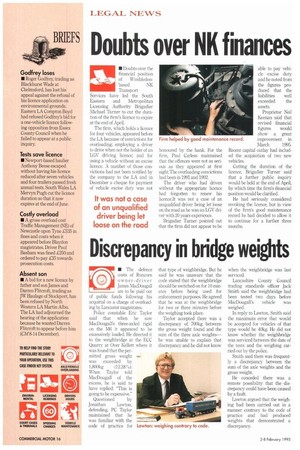Discrepancy in bridge weights
Page 18

If you've noticed an error in this article please click here to report it so we can fix it.
fli IN The defence
costs of Runcorn owner-driver James MacDougall are to be paid out of public funds following his acquittal on a charge of overloading by Lancaster magistrates.
Police constable Eric Taylor said that when he saw 1VlacDougall's three-axled rigid on the M6 it appeared to be excessively loaded. He directed it to the weighbridge at the FCC Quarry at Over Kellett where it was found that the permitted gross weight was exceeded by 1,800kg (1228%). When Taylor told MacDougall of the excess, he is said to have replied: This is going to be expensive."
Questioned by Jonathan Lawton, defending, PC Taylor maintained that he was familiar with the code of practice for that type of weighbridge. But he said he was unaware that the code stated that the weighbridge should be switched on for 10 minutes before being used for enforcement purposes. He agreed that he was at the weighbridge for two or three minutes before the weighing took place.
Taylor accepted there was a discrepancy of 700kg between the gross weight found and the sum of the three axle weights— he was unable to explain that discrepancy and he did not know when the weighbridge was last serviced.
Lancashire County Council trading standards officer Jack Smith said the weighbridge had been tested two days before MacDougall's vehicle was weighed.
In reply to Lawton, Smith said the maximum error that would be accepted for vehicles of that type would be 40kg. He did not know whether the weighbridge was serviced between the date of the tests and the weighing carried out by the police.
Smith said there was frequently a discrepancy between the sum of the axle weights and the gross weight.
He conceded there was a remote possibility that the discrepancy could have been caused by a fault Lawton argued that the weighing had been carried out in a manner contrary to the code of practice and had produced weights that demonstrated a discrepancy.
































































































